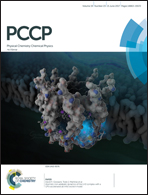GaS0.5Te0.5 monolayer as an efficient water splitting photocatalyst†
Abstract
Herein, two-dimensional materials for photocatalytic water splitting are drawing more attention due to the larger surface areas for photocatalytic reactions and shorter migration distances for photogenerated carriers. In this present study, we systematically investigated the fundamental electronic properties of GaS1−xTex monolayers (x = 0, 0.125, 0.25, 0.5, 0.75, 0.875, and 1) for water splitting based on density functional theory (DFT) using the HSE06 functional. The simulation of the defect formation energy under each experimental synthetic condition shows that the Te substitutional impurity in GaS can be relatively easily realized under Ga-rich conditions. Our results show that the GaS0.5Te0.5 monolayer is a direct band gap (2.09 eV) semiconductor, which is attributed to the elevation of Te px/py states at the Γ point by the strain effect. Moreover, the GaS0.5Te0.5 monolayer has appropriate band edge alignment with respect to the water redox potentials in both acidic and neutral environments. Additionally, the carrier effective mass of the GaS0.5Te0.5 monolayer along the direction of Γ → K is smaller than those of pristine GaS and GaTe monolayers, which can cause the carriers to quickly transfer from the photogenerated center to the surface of the photocatalyst. These results imply that the GaS0.5Te0.5 monolayer is a promising candidate as a visible-light water splitting photocatalyst, which should be properly synthesized and tested in further experimental investigations.



 Please wait while we load your content...
Please wait while we load your content...